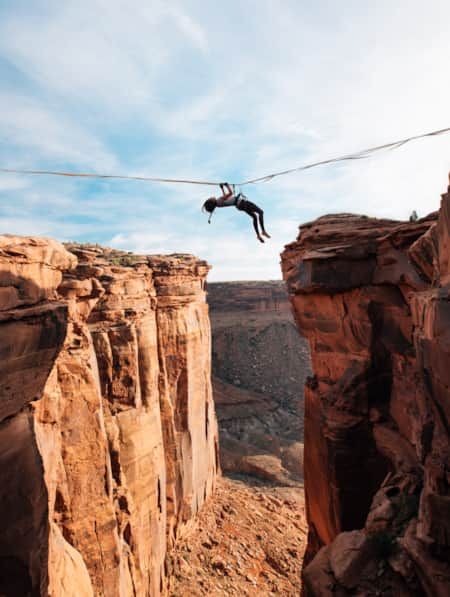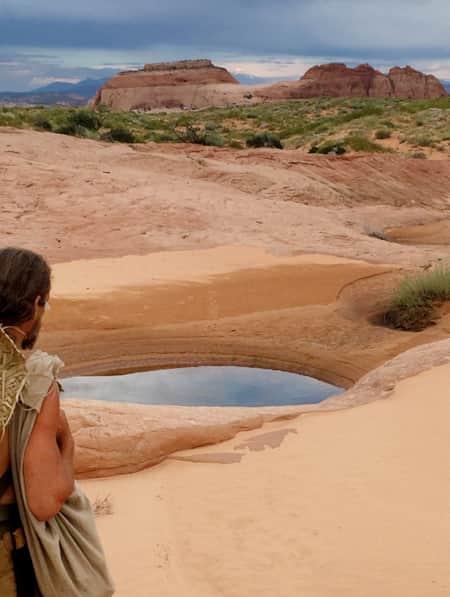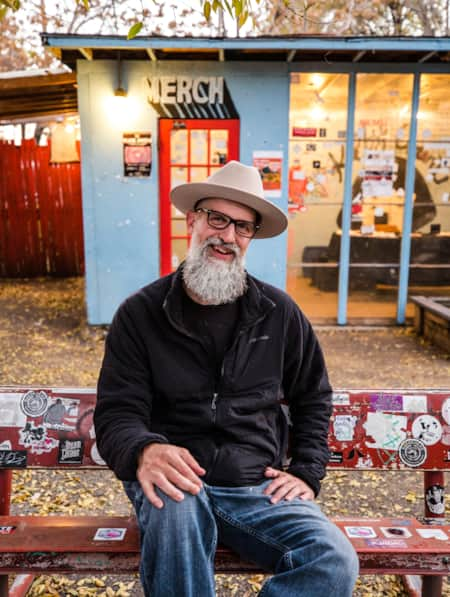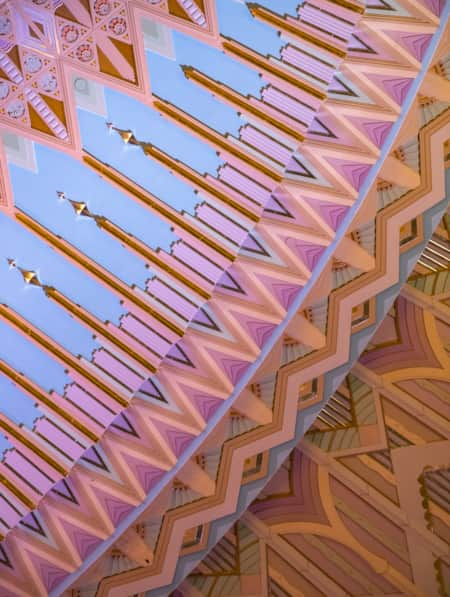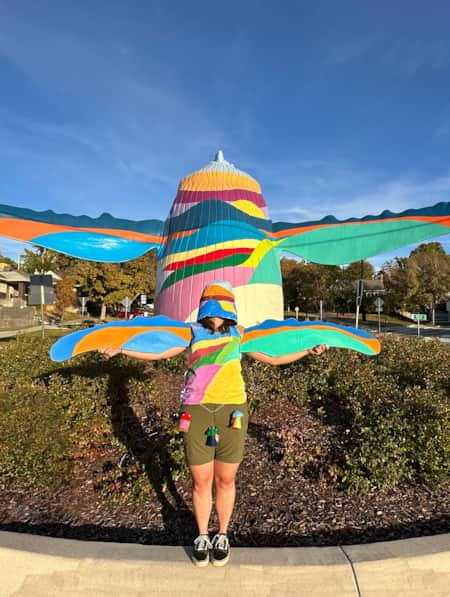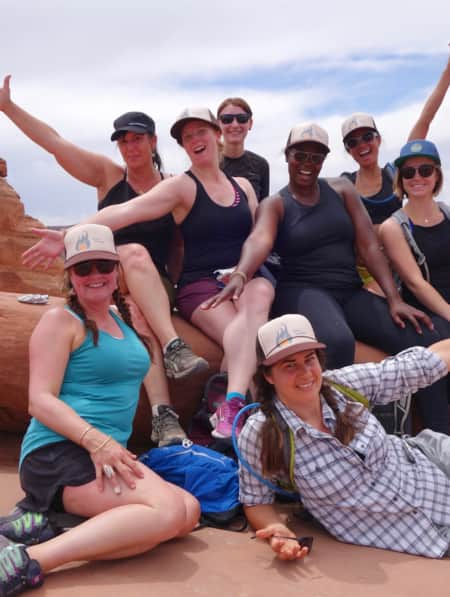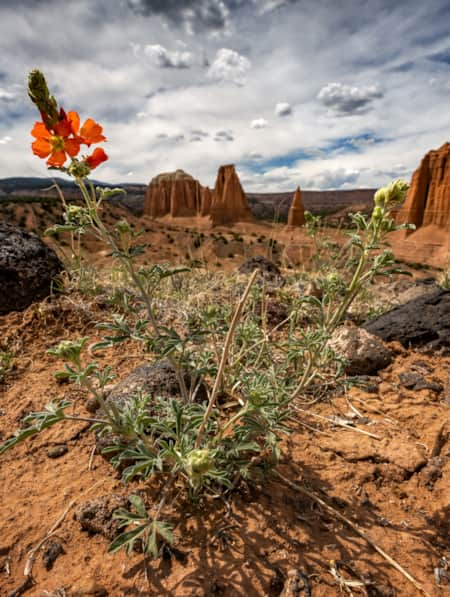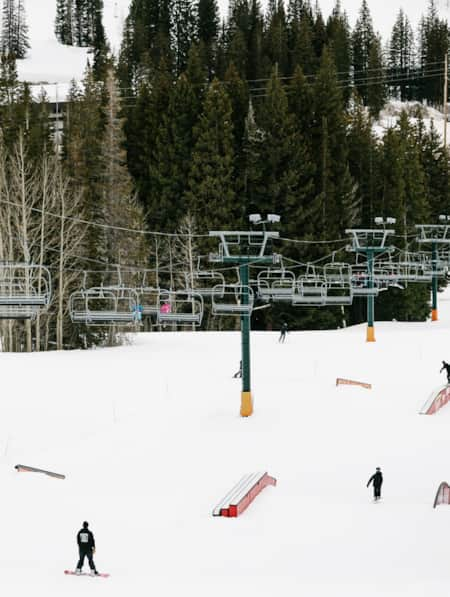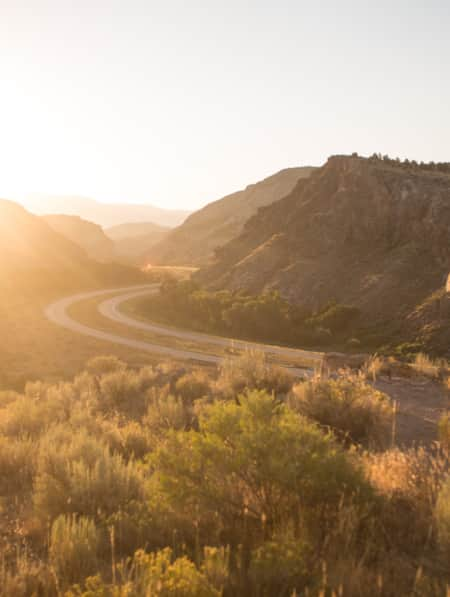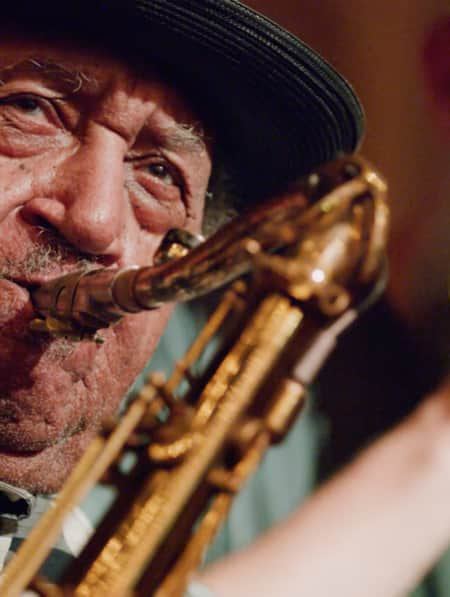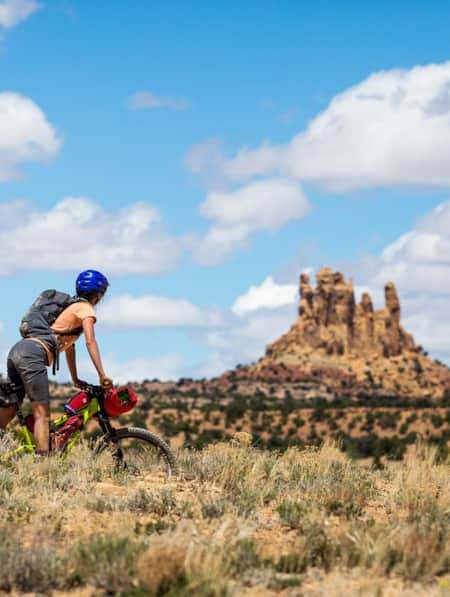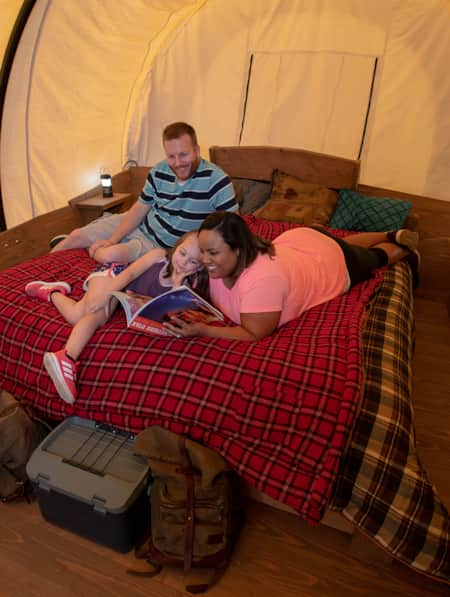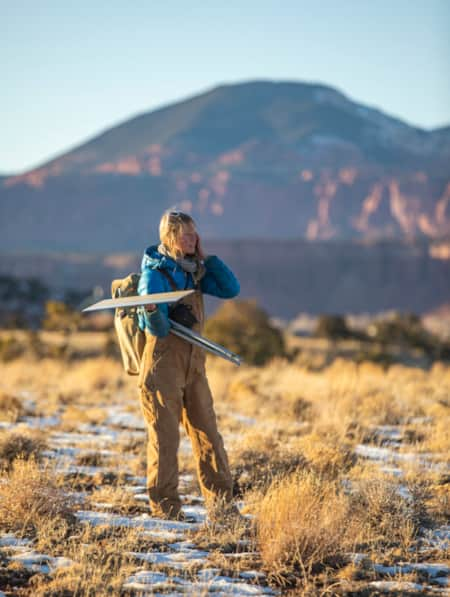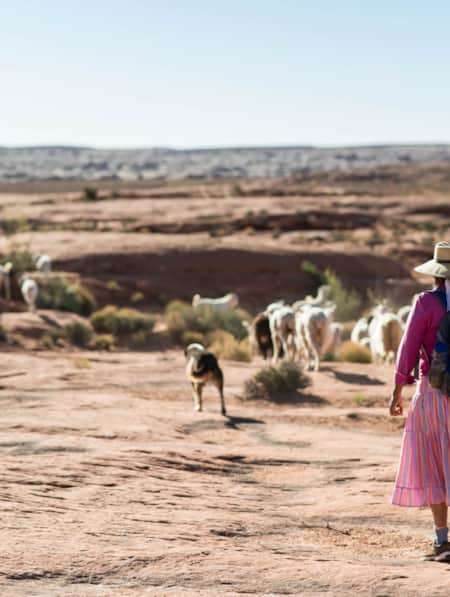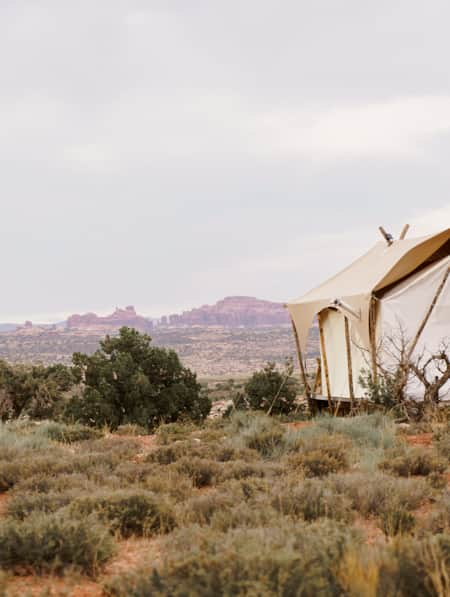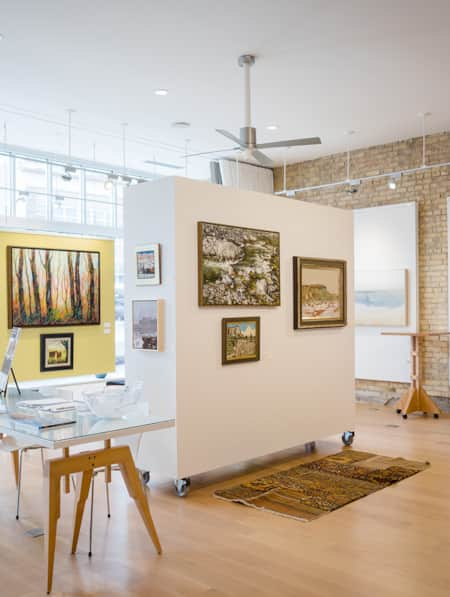A Guided Adventure for Everyone in Utah's National Parks
Thinking of hiring a guide? Leaving the planning to someone else and learning more about backpacking are just a few of the perks Melissa Fields realized when she let a pro lead the way through Capitol Reef National Park.

“Every new kangaroo wants chocolate milk,” said Ashleigh, reciting the mnemonic device she uses to remember the layer cake-like rock layers exposed in Capitol Reef National Park's most distinguishing land feature, the Waterpocket Fold. I trailed closely behind her, listening as she pointed out the silty, reddish-orange Entrada sandstone (every); creamy-white Navajo sandstone (new); maroon-lavender Kayenta (kangaroo); towering burnt-sienna Wingate sandstone (wants) walls, often striped with black streaks called desert varnish; broken up or “messy,” as she described it, gray-green Chinle Layer (chocolate); and the rippled Moenkopi layer (milk), which at 245 years old, is thought to be oldest exposed rock in Capitol Reef.
Ashleigh’s clever geology lesson took place in early May on the first morning of a three-day, two-night, guided backpacking trip with Good Trip Adventures. This particular trip was for women travelers, but Good Trip leads an array of affinity tours with a commitment to all people accessing the outdoors. Along with Ashleigh, and the trip’s other guide, Lia, the rest of the group included a nurse from New Jersey; a Cornell graduate in between jobs and living with her fiancé in what is likely Utah’s most well-known desert destination, Moab; the hilarious massage therapist in the midst of a work sabbatical after ending a five-year relationship; the ski patroller/photographer from California; the dog-loving veterinarian assistant; and me, a freelance writer and mom of two college-age kids. As I walked along the trail with them that first morning, drinking in the sweeping desert views and learning from Ashleigh and Lia about the rocks, plants and the blooming desert wildflowers along the way, I couldn’t help but draw parallels between the varying layers exposed by the Waterpocket Fold and the women who had assembled for this trip. Though the lives we led off the trail were certainly very different, it was apparent from the start that we all shared a deep-seated love for being in nature. And we’d all been drawn to sign up for this trip on our own.
"I couldn’t help but draw parallels between the varying layers exposed by the Waterpocket Fold and the women who had assembled for this trip. Though the lives we led off the trail were certainly very different, it was apparent from the start that we all shared a deep-seated love for being in nature."
– Author Melissa Fields

The park’s name combines the popular term for an uplifted landmass, “reef,” with a visual resemblance of the park’s many white Navajo Sandstone domes to that of the nation’s Capitol Building.

Capitol Reef National Park is located in south-central Utah. The park can be reached from I-70 via S.R. 24. From the Salt Lake City International Airport, the trip takes a little less than four hours.
Redefining Guide Culture
The almost universal benefits of spending time outdoors is a big part of why Megan Kennedy founded Good Trip Adventures back in 2020, just months after the world shut down due to the pandemic. Before then she’d guided in the United Kingdom and in New York State and didn’t particularly like what she saw. “People are trained by all levels of the outdoor industry that the outdoors is for a very specific kind of person,” she said. And so she and some of her colleagues hatched an idea for a “better guiding company, with a more horizontal hierarchy, where those who have been traditionally excluded from the outdoors would feel welcome and could experience the learning and making greater connections with self, others and a place that is unique to spending time in nature.” This inclusivity-based philosophy seems to be resonating. Good Trip now guides in 30 national parks nationwide, including all five of Utah’s national parks. The company is women and queer-owned and more than 75 percent of the staff are queer, women or BIPOC. “Creating a safe space where people can learn and ask questions informs everything that we do,” Kennedy said.
Getting an opportunity to ask questions is how my Good Trip Capitol Reef backpacking trip began. A week before we set foot on the trail, me and the other trip participants met with Ashleigh and Lia on Zoom. After chatting a bit about our backgrounds and backpacking experience, the guides went over the itinerary and gear lists—including their personal gear choices—and checked out our backpacks. When I trained my computer camera on the pack I planned to take on this trip—a roughly 40 liter pack I’d been using intermittently in the decades since college—Lia said, “I would try to get something bigger, at least 55 liters.” Ashleigh concurred. “Yeah, a bigger pack will make the morning repack go much smoother,” she said. Though I was skeptical, I ended up buying a very gently used 60-liter pack from REI and, boy, was I glad I did.
The original itinerary was centered around Capitol Reef’s Halls Creek Narrows, a super-remote slot canyon located in the far southern tip of the park. But weather forecasts calling for a 40 percent chance of rain (slot canyons are to be avoided at even the slightest whiff of rain), as well as a toxic cyanobacteria bloom in the narrows’ perennial stream (water filters, UV light pens, iodine, boiling, etc. do not kill this type of bacteria, which is toxic to both humans and animals), made the guides pivot to an overland route running through the heart of the Waterpocket Fold—a route with no natural water sources. What this meant was that, though we would come back to trailheads where we could refill our water containers between nights spent in the backcountry, we each had to carry enough water for drinking, cooking and washing for a 24-hour period, or about eight liters. My new bigger pack not only had the space for all that water, but allowed me to carry it much more comfortably than if I had attempted to lash those awkward water bags to the outside of my old pack.
Other tips Lia and Ashleigh imparted during that meet-and-greet call, like the pack-size advice, turned out to be absolutely accurate as well, including the miracle that is the Kula cloth, an antimicrobial pee cloth that Ashleigh attested “keeps my underwear just a little fresher while backpacking,” (True!) and Lia’s thoughts about rain pants. “I’m not bringing them, and you probably won’t need to use them.” I chose not to follow the latter piece of advice and, as predicted, ended up returning the rain pants I’d purchased the night before leaving for the trip—and carried for three days in my pack—back to the store when I got home. (Lesson learned!)

For travelers who find serenity in seclusion, Capitol Reef’s sprawling red rock hiking may be tough to beat.
Photo: Savannah McCauley

Many beginning hikers and newcomers to Utah are perplexed — by the prospects of hiking the “desert.” Actually, the desert is a diverse country of deep canyons, high plateaus and rich archaeological history.
Photo: Savannah McCauley

Camping in Capitol Reef National Park harkens to an ancient time when the American Southwest was formed by the raw power of the elements.
Photo: Savannah McCauley
"Creating a safe space where people can learn and ask questions informs everything that we do."
– Megan Kennedy, founder of Good Trip Adventures

Breaking the Ice
Before signing up for this trip, I’d never traveled with people who weren’t friends or family. And so, one week after our video call, when Lia pulled a Good Trip van up in front of the Wild Rabbit Café, an adorable eatery in Capitol Reef’s gateway town, Torrey, where I had arranged to meet the group, I honestly didn’t know what to expect. But when I swung open the sliding door and stepped inside the van, I was immediately bathed in the group’s excitement and anticipation for the three days ahead. Their adventure had begun back in Salt Lake City where Ashleigh and Lia had done pickups at the airport and other predetermined meetup points. But I felt like I hadn’t missed a thing as we chatted and got to know each other on the seven-mile drive from Torrey into Capitol Reef.
Night one was spent in the park’s Fruita Campground, a grassy oasis tucked along the Fremont River and surrounded by apple, cherry, peach and apricot orchards planted in the 1880s by pioneer members of the Church of Jesus Christ of Latter-day Saints (Read: Capitol Reef National Park Orchards In Fruita). Throughout the summer and fall, Capitol Reef rangers post “U-Pick” signs in these legacy orchards when they are pick-ready; harvest info is also available by calling the park’s fruit hotline at (435) 425-3791. Ashleigh and Lia paired up tent mates and then patiently showed us how to set up the Good Trip-provided tents and inflatable sleeping pads. One woman in our group had never camped before and I couldn’t help but think how thoughtful and more comfortable it was for her to get oriented to sleeping outdoors there on the grass — within a stone’s throw of running water and flush toilets — rather than in the backcountry after her first-ever day of backpacking.
The sun was shining the next morning as we ate breakfast and struck camp. Ashleigh led us through a few yoga poses before we divided up the communal items, shouldered our packs and stepped onto the Cohab Canyon trail. The landscape that surrounded us on each step of the next two-and-a-half days included narrow slot canyons; towering, desert varnish-streaked sandstone walls; and craggy hills peppered with wildflowers, yucca, sagebrush and Utah juniper and two-needle pinyon pine trees. The places we pitched our tents during our two nights in the backcountry were nothing short of spectacular as well. The first was a secluded playa, or dry lakebed, surrounded by Navajo sandstone formations with a graceful sand dune at one end. The other was a spacious sandstone shelf, spanning at least 20,000 square feet, flanked by house-sized boulders and one side and airy views of the Fremont River Valley on the other. Some of my favorite memories of the trip happened at these campsites as we sat around the camp stove laughing and watching Lia make dinner (which both nights was, gratefully, real food versus freeze-dried dinners). And as if those evenings weren’t magical enough, our two nights in the backcountry also included aurora sightings, providing an even more spectacular show of the unfettered night skies that Capitol Reef is known for (Read: Dark Skies in Capitol Reef National Park).
Along with inclusivity, another tenant of Good Trip Adventures’ mission is to offer travel that minimizes impact on the earth. On a broad scale, Good Trip accomplishes this goal with practices like purchasing carbon offsets for each trip it runs; allowing flexible, remote working options for staff; and supporting forest regeneration projects. Out in the field, I observed Ashleigh and Lia incorporating sustainability within every aspect of the trip. Before we hit the trail, Lia gave each of us bathroom kits that she’d stocked with toilet paper, wipes and opaque bags allowing us to discreetly carry out our own bathrooming trash. She and Ashleigh also took care to minimize the trash we took into the backcountry by removing most of the food packaging before divvying up parts of the meals among the group. They brought along plenty of extra Ziploc bags to package our communal trash so that no one would feel hesitant to take their turn carrying it out. And each morning after we’d repacked our gear and were about to hit the trail, we’d line up and do a sweep of our entire campsite, scanning the ground for microtrash or any small items we may have overlooked while packing up. (Read: How to Keep Utah Forever Mighty)

An often unforeseen benefit of hiring a guide is the opportunity to create lasting friendships with initial strangers through a uniquely shared experience.

In the backcountry, the demands of modern life are far off. There is no place you need to be other than where you are in the moment, and no thing you need to do other than the task at hand.

Free from digital distraction, away from the all-consuming to-do list, enveloped in nature's embrace and supported by the newfound trust in your fellow guides and adventurers, unforgettable memories and enduring friendships blossom.
Solo But Far from Isolated
Going with a guide 100-percent checked both of the boxes I had hoped for when I signed up for this trip: getting to leave the planning to someone else and learning more about backpacking. But, far and away, the best perk was getting to meet and connect with such a diverse and outdoorsy group of women. It’s hard not to attribute how quickly the group fell into a pattern of mutual support, cooperation and just plain chumminess to the fact that we were all solo and all women. Reasons those ladies gave for coming on the trip varied from not having backpacking types in their existing friend group to wanting to go camping without the “bro” factor. Sara, the dog-loving vet tech, had never backpacked without her husband before and signed up for the trip “to prove that I can do hard things by myself,” she said. “I was also really needing a reset and the experience was very much that. I came home feeling more like myself, which I hadn’t felt for a while.”
Though those four days were chock full with laughs and great conversation, a particularly sweet and empowering moment occurred on day two in the backcountry. The morning started out breezy and cool, but by afternoon the wind had died, and it got quite warm—just in time for a 1,200-foot-elevation-gain climb along the aptly named Frying Pan Trail. While I basked in the beauty of multilayered desert scenery along the way, which included several panels of pock-marked sandstone canyon walls, called tafoni, and a bird’s-eye view of the seven slots canyons known as The Wives, I also found myself digging deep to keep me and my fully loaded pack moving up the trail. The group’s typically animated conversation waned as we made the final trudge to the ridgeline. When I finally arrived at the top, I immediately dumped my pack and stretched out on the ground. One by one, the other women joined me, each as red-faced and sweaty as I was. When we’d all made it, we laughed, enjoyed the ridgeline’s cool breezes and linked arms to take a celebratory group photo.
In the weeks following the trip, I found myself thinking often about how fond I had become of the other women I’d been out there with. Even more extraordinary to me is how that affection had evolved within such a short period of time. I don’t really know how that trip accelerated the typical friendship timeline. Maybe it’s being completely separated from the distractions and obligations of real life or spending time in such a beautiful landscape with like-minded people. I suspect it was both of those things and likely more, and it is also an experience not unique to our group. “Watching those deep bonds form is one of my favorite parts of leading backpacking trips,” Lia said when I followed up with her for this story after we all had returned to our normal lives. Regardless of why, that trip redefined my preconceived notions of what going solo on a guided group trip means: a rare chance to move through a landscape I’d probably not get to on my own while making precious new connections along the way.
"That trip redefined my preconceived notions of what going solo on a guided group trip means: a rare chance to move through a landscape I’d probably not get to on my own while making precious new connections along the way."
– Author Melissa Fields
A Fitting End-of-the-Trail Celebration
Our last day was spent leisurely strolling out of the park along the Capitol Gorge Trail, having lunch at the picnic tables off the park’s Scenic Loop, complete with fresh cherry and peach pies from the Gifford House Store and Museum (Read: Utah’s Pie-Ala-Road), and playing in Sulphur Creek (which runs behind the Capitol Reef Visitor Center). Late that afternoon the group returned to Torrey and checked into the Skyview Hotel, which opened in 2023 with modern, well-appointed rooms, clear-roofed geodesic domes and a huge rooftop patio to take advantage of Torrey’s status as Utah’s first official International Dark Sky Community. After showers and some relaxing time, we dressed in our in-town clothes and headed to the cozy Hunt & Gather restaurant for dinner, which is nationally recognized for its dedication to local sourcing, environmental impact, cultural connection, community involvement, staff support and business values. Hot tubbing and stargazing back at the Skyview commenced after dinner.
In the morning, we gathered for breakfast back at the Wild Rabbit Café. While we waited for our omelets, housemade pastries and espresso drinks to arrive, we browsed through the café’s two connected businesses, Color Ridge Creamery and Shooke Coffee Roasters. There I watched Shawn, part owner and chief roaster for Shooke, pull a batch of beans out of the onsite roaster before I bought a pound of Shooke’s Cathedral Valley blend to take home with me. Other women bought locally-made jewelry, pottery and stickers on display throughout the space. After breakfast, we wandered back out to the van for a final group photo, hugs and to say, ‘so long,’ pledging to get back together in nature another time soon.

It was in the 1880s when early Mormons first settled a lush valley in the heart of today’s Capitol Reef National Park. They planted orchards filled with cherries, peaches, pears and apples and called this fertile vale Fruita.
Photo: Austen Diamond

The Gifford House in Capitol Reef serves up a slice of history with personal-sized pies made with orchard fruits.
Photo: Austen Diamond

Guides and Outfitters
Guides and outfitters allow you to deeply experience the outdoors, without any planning or wayfinding stressors.

Capitol Reef National Park
Even considering Utah’s many impressive national parks and monuments, it is difficult to rival Capitol Reef National Park’s sense of expansiveness, of broad, sweeping vistas, of a tortured, twisted, seemingly endless landscape, or of limitless sky and desert rock.
Things To Do in Capitol Reef National Park
-
Camping
As one of Utah’s less crowded national parks, there is plenty of camping to choose from. Start your day nestled beside the Fremont River in the lovely Fruita Campground, or explore the two free primitive campgrounds further into the park.
-
Canyoneering
Utah is known around the world for its spectacular slot canyons, many of which are found in Capitol Reef National Park. Explore the park’s most popular routes, learn about the required permits, and prepare for your trip here.
-
Hiking
For travelers who find serenity in seclusion, Capitol Reef’s sprawling red rock hiking may be tough to beat. There are plenty of hiking trails out of the Fruita area and along the scenic drive to spread out and experience the varied environments of Capitol Reef. Or spend the day winding through the park’s awe-inspiring slot canyons.
-
Scenic Drive
In many parks the most beautiful destinations can’t be seen from the road. That’s not the case at Capitol Reef. Ramble down the 8-mile Capitol Reef Scenic Drive for breathtaking viewpoints and more likely than not, some great conversation. The Scenic Drive is a paved road, suitable to passenger vehicles. Beyond the paved road are two dirt spur roads, Grand Wash and Capitol Gorge. These dirt spur roads enter canyons and lead to trailheads, and are usually suitable for passenger cars and RVs up to 27 feet in length.
-
Slow Down
Capitol Reef isn’t the type of place that calls for a packed itinerary. Slow down a bit while you’re here — visit the Pioneer Register site to see the names of historic miners and settlers, or visit the historic district of Fruita to pick fruit from its orchards.
-
Winter Activities
Towering red rocks dusted in snow, often set against bright blue skies, welcome winter visitors to Capitol Reef National Park. Skip the summer crowds and bundle up for an unforgettable winter adventure. Soak up incredible views along the park’s scenic drive or gear up and head out on a wintry hike. After the sun sets, watch dazzling stars shimmer against a brilliant and crisp night sky.





